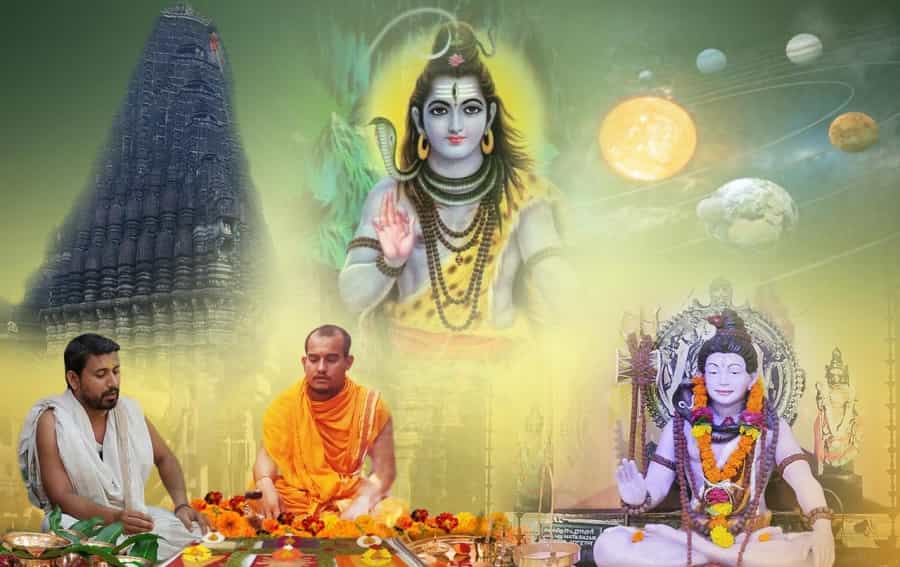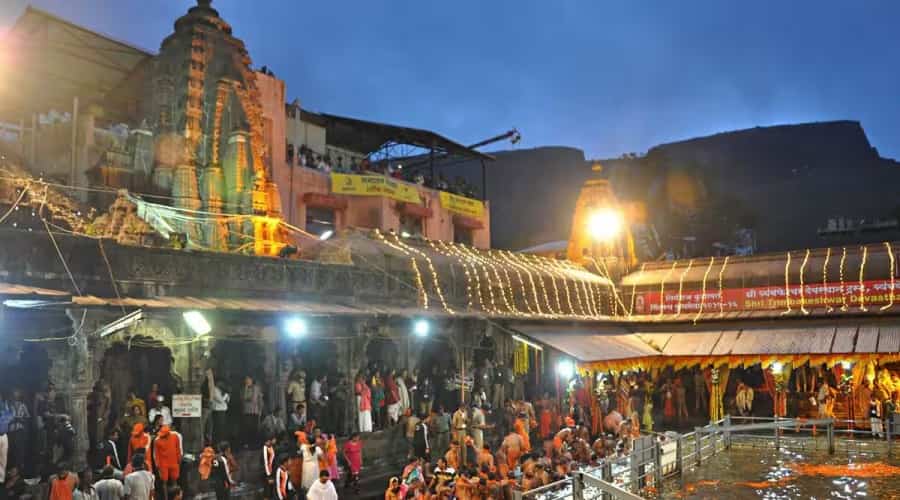Trimbakeshwar Temple, one of the holiest and most revered temples in India, is situated in the town of Trimbak in the Nashik district of Maharashtra. Dedicated to Lord Shiva, this temple is not only a place of worship but also holds immense cultural and historical significance. The temple is renowned for its unique rituals and ceremonies that draw devotees from far and wide. In this detailed guide, we will explore the temple’s daily schedule, important rituals, and the cultural context surrounding this spiritual sanctuary.
- Entry Fee: No entry fee

Temple Timings
Trimbakeshwar Temple follows a structured schedule, with specific timings for various rituals and darshan (viewing of the deity). It is essential to be aware of these timings when planning your visit to ensure a fulfilling and spiritually enriching experience.
Darshan Timings
The temple opens for darshan (viewing of the deity) from 5:30 AM in the morning and remains accessible until 9:00 PM in the evening, allowing devotees to seek blessings throughout the day.
Rudrabhisek Timings
The sacred Rudrabhisek, a ritual involving the offering of sacred items to the deity, takes place between 7:00 AM and 8:30 AM each day. Devotees can participate in this ceremony during these hours.
Special Pooja Timings
Special poojas, marked by their unique significance, are held at three different times during the day: at 7:00 AM, 1:00 PM, and 4:30 PM. These timings provide opportunities for devotees to engage in special worship rituals.
Afternoon Pooja
A brief afternoon pooja is conducted from 1:00 PM to 1:30 PM, allowing visitors to participate in a shorter but meaningful worship experience.
Shiva Golden Crown
The adorning of the Shiva deity with a golden crown is a spectacle that takes place from 4:30 PM to 5:00 PM. Witnessing this ceremony adds to the spiritual ambiance of the evening.
Daily Rituals
Trimbakeshwar Temple is renowned for its rich and intricate rituals that are performed daily. These rituals have been passed down through generations and are an integral part of the temple’s heritage. Some of the essential daily rituals include:
Morning Aarti
The morning aarti marks the beginning of the day at Trimbakeshwar Temple. Priests perform aarti with incense, lamps, and other offerings, accompanied by melodious chanting of sacred hymns. Devotees gather to witness this sacred ritual, which is believed to purify the atmosphere and invoke the blessings of Lord Shiva.
Rudrabhishek
This is a significant daily ritual where the Shiva Linga, the representation of Lord Shiva, is bathed with a mixture of water, milk, yogurt, honey, and ghee. The ritual is performed while chanting Vedic mantras. Devotees can participate in or observe this ceremony, as it is considered highly auspicious.
Panchamrut Abhishek
Panchamrut Abhishek involves offering five sacred substances, including milk, yogurt, honey, sugar, and ghee, to the Shiva Linga. It is a gesture of devotion and respect towards Lord Shiva.
Shejaarti
The Shejaarti is the evening aarti performed as the temple prepares to close for the day. Devotees gather to witness the grand spectacle of lamps and incense, creating a spiritual ambiance. This aarti marks the conclusion of the day’s worship.
Temple Decoration
The temple is adorned with flowers, garlands, and traditional decorations, adding to its visual appeal. The decoration varies according to seasons, festivals, and special occasions.
Vedic Chants
Throughout the day, temple priests recite Vedic hymns and mantras, creating an atmosphere of spirituality and devotion. The vibrations of these chants are believed to have a positive impact on the surroundings.
Bhajan and Kirtan
Devotional songs, bhajans, and kirtans are frequently performed inside the temple premises. These devotional activities engage and uplift the spirits of the devotees, adding to the overall experience.
Festivals and Special Occasions
Trimbakeshwar Temple celebrates numerous festivals and special occasions throughout the year. These events add vibrancy to the temple’s ambiance and provide devotees with unique opportunities to connect with Lord Shiva. Some of the prominent festivals and special rituals include:

Mahashivratri
Mahashivratri, the Great Night of Shiva, is one of the most significant festivals celebrated at Trimbakeshwar Temple. It usually falls in February or March. On this day, the temple witnesses a massive influx of devotees who come to seek Lord Shiva’s blessings. The celebrations include an all-night vigil, Rudrabhishek, and a grand procession.
Shravan Maas (Holy Month of Shravan)
The month of Shravan (July-August) is considered highly auspicious for Shiva worship. During this month, devotees flock to the temple to offer water from the holy Godavari River to the Shiva Linga. The temple’s premises are beautifully decorated, and special pujas (rituals) are conducted.
Kumbh Mela
Trimbakeshwar hosts the Kumbh Mela once every 12 years, rotating with Prayagraj, Haridwar, and Ujjain. The Kumbh Mela at Trimbakeshwar draws millions of pilgrims who come to take a dip in the sacred Godavari River and seek spiritual enlightenment.
Triambkeshwar Utsav
This is an annual festival held in the town of Trimbak, celebrating the temple’s significance and history. The event includes cultural programs, processions, and special pujas at the temple.
Guru Purnima
Guru Purnima is a day to honor and pay respect to spiritual gurus. Devotees visit Trimbakeshwar Temple to seek the blessings of their gurus and express gratitude for their guidance on the spiritual path.
Nag Panchami
Nag Panchami is dedicated to the worship of snakes, which are considered sacred in Hindu mythology. The temple sees special rituals and offerings made to snake deities on this day.
Cultural Significance
Trimbakeshwar Temple is not only a place of religious worship but also holds immense cultural and historical significance. Here are some key aspects of its cultural importance:
Jyotirlinga
Trimbakeshwar is one of the twelve Jyotirlingas (sacred shrines) dedicated to Lord Shiva. These Jyotirlingas are believed to be self-manifested forms of Lord Shiva, and they hold a special place in Hindu mythology. Trimbakeshwar, with its unique linga representing Brahma, Vishnu, and Mahesh (Shiva), is a revered pilgrimage site for Shiva devotees.
- Suggested Tour: Maharashtra Jyotirlinga Tour Package
Godavari River
The Godavari River, which flows near the temple, is considered one of the holiest rivers in India. Devotees often take a dip in the Godavari as a purifying ritual before visiting the temple. The presence of the river adds to the spiritual significance of the temple.
Historical Legends
The temple is associated with several historical legends and myths, including the origin of the Godavari River and the significance of the Trimbak town. These stories are an integral part of the temple’s cultural heritage.
Architectural Marvel
Trimbakeshwar Temple is an architectural marvel with its unique Hemadpanti-style construction. The temple’s intricate carvings, stone pillars, and ornate ceilings are a testament to the craftsmanship of the artisans of that era.
Religious Harmony
The temple is a symbol of religious harmony, as it welcomes devotees from various religious backgrounds. It is not restricted to followers of Hinduism but embraces people from all walks of life, promoting unity and diversity.
Visiting Trimbakeshwar Temple is a holistic experience that encompasses spirituality, history, and culture. Devotees and tourists alike find solace and inspiration within its sacred walls.
Practical Information for Visitors
Dress Code
Devotees are expected to dress modestly when visiting the temple. Avoid wearing revealing or inappropriate attire. It is also customary to remove footwear before entering the temple premises.
Photography
While photography is allowed in the temple complex, be respectful of the rules and guidelines. Some areas may be off-limits for photography, and it is important to seek permission from authorities if you plan to capture specific rituals or events.
Offerings
The temple provides facilities for making offerings to the deity. Devotees can purchase flowers, coconuts, and other items within the temple complex or bring their own offerings.
Crowd Management
Trimbakeshwar Temple can get very crowded, especially during festivals and special occasions. Be prepared for long queues and exercise patience.
Local Cuisine
Don’t miss the opportunity to savor local Maharashtrian cuisine in the town of Trimbak. Authentic dishes such as vada pav, misal pav, and puran poli are popular among visitors.
Accommodation
Trimbak offers various accommodation options, including hotels and lodges for visitors who wish to stay in the town. Nashik, located about 30 kilometers away, also provides additional lodging choices.
Conclusion
Trimbakeshwar Temple, with its unique architectural beauty, historical legends, and intricate rituals, is a beacon of spirituality and cultural significance in India. Visiting this temple provides an opportunity to connect with Lord Shiva, soak in the ambiance of devotion, and explore the rich cultural heritage that surrounds it. Whether you are a devout follower of Lord Shiva or a curious traveler, a visit to Trimbakeshwar Temple is a memorable and enriching experience that offers a glimpse into the soul of Indian spirituality.
Also Know 

 Call
Call WhatsApp
WhatsApp Enquiry
Enquiry
Hello,
What is the cost for Maha Mrityuanjaya Pooja and Rudrabhishekam
kindly share your contact details
I HEARD FROM SOMEONE THAT OFFERING WATER AND FLOWERS ON SHIVALINGAM NOT ALLOWED IN TRAYAMBKESHWER .ONLY WE CAN TAKE DARSHAN .IS IT TRUE ? PLEASE TELL ME AS I WILL VISIT THERE NEXT MONTH. IS 12 NOON A GOOD TIME TO VISIT ON MONDAY? KINDLY RESPOND